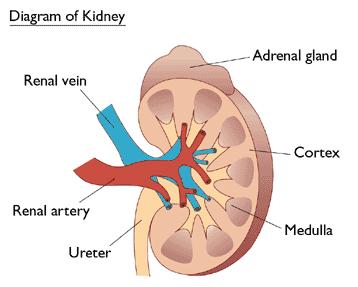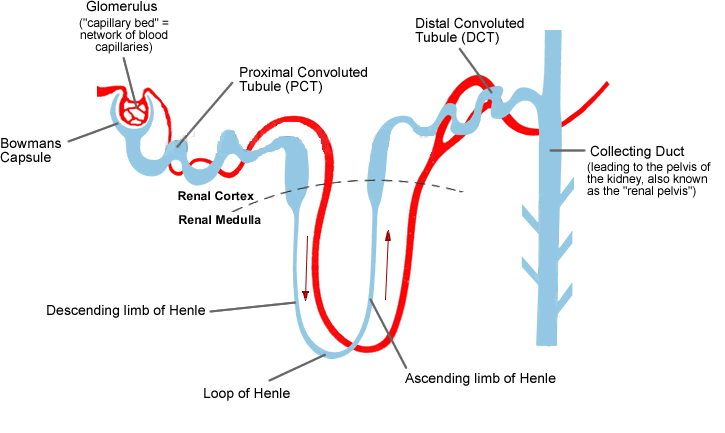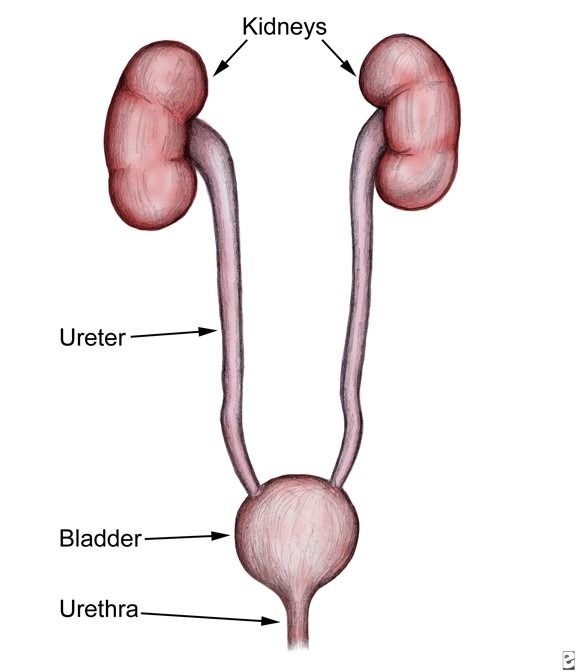SYLLABUS STATEMENTS: 2.69 - 2.76
WHAT DO KIDNEYS DO?
They’re a very very important part of our bodies actually. Simply, they filter our blood and remove the waste products. These waste products are contained in urine.

This is the kidney. Take a quick look because I’ll be talking about structures of the kidney next and it will be handy to remember how it looks.
HOW DO THEY WORK?
The most important structure in the Kidney is the Nephron. These little guys are what makes the magic happen in the kidney. They’re located in the cortex of the kidney (the outer bit)

In real life the nephron is a tangled up mess of tubes but this diagram shows all these tubes and capillaries straightened out so you can see what’s going on.
BOWMAN'S CAPSULE
The Bowman’s capsule is the little guy that filters the blood. Inside the Bowman’s capsule there is a structure called the Glomerulus which put simply is just a bunch of capillaries. As they enter the glomerulus, the diameter of these capillaries suddenly gets smaller. If you studied your physics well (or just have common sense) you will know this leads to an increase in pressure of the blood inside. Now remember we said before (in a previous post) that capillaries are porous (have holes in them)? Well when the pressure increases, small molecules in the blood are forced through and out these holes and into the bowman’s capsule. This is called ultrafiltration, and the filtrate (stuff that comes out of the capillaries) is called the glomerular filtrate.
SO WHICH MOLECULES ARE FILTERED OUT AT THE BOWMAN'S CAPSULE?
Molecules like salts, Urea (waste product), water and glucose. We’re quite content with losing some salts and very happy about getting rid of urea but we don’t really want to go about loosing too much water or any glucose really, as they’re quite important to us.
NEXT STOP: PROXIMAL CONVOLUTED TUBULE (PCT)
This is a very very important part of the nephron. This is where all important Glucose gets reabsorbed (put back) into the blood. This reabsorption happens via active transport and requires energy. An important thing to not is that EVERY SINGLE DROP of glucose is reabsorbed. Absolutely none should be found in the urine of a normal person. If you have diabetes however, you will have glucose in your urine.
ARE WE THERE YET? COLLECTING DUCT
Yes there are parts in between the PCT and the collecting duct and yes you do need to remember what and where they are but they don’t do anything (that you need to know about) so were going straight onto the collecting duct. In the collecting duct water is reabsorbed into (put back into) the blood by osmosis which doesn’t require energy. Obviously not all water is reabsorbed or our urine would be pretty solid. What may surprise you is that the amount of water reabsorbed into the bloodstream and the amount of water in your urine is cleverly controlled by a little guy in your brain called your hypothalamus
ADH AND OSMOREGULATION
So there is a hormone called ADH which travels in your bloodstream and it is very very important hormone for osmoregulation (osmoregulation basically being how much water is in your urine). ADH stands for Anti diuretic hormone, a diuretic being something that decreases the amount of water reabsorbed in the collecting duct. So an anti diuretic must be something that increases the amount of water reabsorbed. On a larger scale, diuretics will increase the volume of your urine and you will have lots of water in your urine. Loads of ADH on the other hand will decrease the volume of your urine and there will be less water.
COME ON! CUT TO THE CHASE, HOW DOES IT WORK?
Ok. So lets say for example that you’re playing a match of high intensity table tennis. You are sweating to try and cool down and because of that you’re loosing water. The hypothalamus detects that the blood has a low water concentration and gives the pituitary gland a ring (please don’t take this literally) and tells it to release ADH. The ADH in the blood goes around and when it gets to the kidney, the kidney detects this extra ADH and makes sure to reabsorb as much water as possible in the collecting duct. The result is your water levels return to normal and when you go to the bathroom you will discover that your urine is very concentrated and doesn’t have much water in it.
AND THEN WHAT? IF THE KIDNEYS ARE ABOVE OUR HIPS THEN HOW DOES URINE GET ALL THE WAY DOWN THERE?
Right well we’re going to need a few diagrams.


So all the collecting ducts of all the millions of nephrons in the cortex all join up and all drain into a little tube called a URETER (note: ureter and urethra are different). This ureter runs all the way down to your bladder where the urine collects until you decide you want to skip a bit of maths class 😉. When you do decide to let it go the urine runs from the bladder through the URETHRA and into the outside world.
AND THAT'S THE KIDNEY DONE GUYS!
Once again I hope this has been useful to you and if anything needs clarification or re-explaining then let me know down in the comments and I will fix it! Also follow my Instagram for updates on when and what I post!